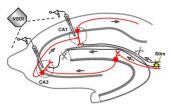(Press-News.org) Ants that are held as slaves in nests of other ant species damage their oppressors through acts of sabotage. Ant researcher Professor Dr. Susanne Foitzik of Johannes Gutenberg University Mainz (JGU) in Germany first observed this "slave rebellion" phenomenon in 2009. According to the latest findings, however, this behavior now appears to be a widespread characteristic that is not limited to isolated occurrences. In fact, in three different populations in the U.S. states of West Virginia, New York, and Ohio, enslaved Temnothorax longispinosus workers have been observed to neglect and kill the offspring of their Protomognathus americanus slavemakers rather than care for them. As a result, an average of only 45 percent of the parasite's offspring survived. This presumably reduces the strength of the parasites in the area and thereby increases the chances of survival for the neighboring colonies populated by the slave ants' relatives.
More than half of all animal species live in parasitic relationships, i.e. they exploit their so-called hosts. From the perspective of evolutionary history, the American slave-making ant Protomognathus americanus is an old social parasite that is entirely dependent on other ant species for its survival. Slave workers have to care for the brood in parasite nests, bring food to their masters and feed them, and even defend the nest.
These ants become slaves when workers from the slave-making ant colony attack the nests of the host species Temnothorax longispinosus, kill the adult ants, and steal the brood. Back in the masters' nest, which can be located in hollow acorns, nutshells, or twigs, the brood care behavior of the emerging slave workers is exploited to the advantage of the slavemaker species. As Susanne Foitzik and her work group have shown, the enslaved worker ants feed and clean the larvae, thereby raising the offspring of their social parasite – but only up to a certain point.
"Probably at first the slaves cannot tell that the larvae belong to another species," explains Foitzik. As a result, 95 percent of the brood survives the larval stage. But the situation changes as soon as the larvae pupate. "The pupae, which already look like ants, bear chemical cues on their cuticles that can apparently be detected. We have been able to show that a high fraction of the slavemaker pupae are killed by slave workers." The pupae are either neglected or actively killed by being attacked and torn apart. Several slaves at once may assault a pupa, which is unable to move or defend itself during the pupal stage and is also not protected by a cocoon.
In parasite nests in West Virginia, only 27 percent of the pupae survived, and in the New York colonies, only 49 percent. In Ohio, the survival chances of the American slave-making ant was a bit higher at 58 percent, but this figure is still well below the survival rate of 85 percent for host pupae in their own free-living nests. "The enslaved workers do not directly benefit from the killings because they do not reproduce," explains Susanne Foitzik. But, through the killing of slavemaker offspring, their neighboring relatives – which might very well be the sisters of the worker slaves – indirectly benefit as their chances of survival are increased. Slavemaker colonies damaged by slave rebellions grow slower and smaller slave-making colonies conduct fewer and less destructive slave raids.
The large differences in the death rates in colonies from different regions fits to predictions derived from the geographic mosaic theory of co-evolution. This theory claims that populations differ because they are subjected to different local selection pressures and because they possess different attack or defense traits originated through mutations, which in turn means that evolution can go in different directions in different geographic areas. While the host ants in New York are very aggressive and often successfully thwart slave raid attempts, the hosts in West Virginia profit more from the slave rebellion behavior because, as genetic analyses have shown, the neighboring colonies are more often close relatives to the rebelling slaves.
###This study on the evolution of slave rebellion has been financed since October 2011 by the project "The evolution of resistance and virulence in structured populations" funded by the German Research Foundation.
Slave rebellion is widespread in ants
Enslaved worker ants kill the offspring of their parasites and thereby improve the chances of survival for their neighboring relatives
2012-09-26
ELSE PRESS RELEASES FROM THIS DATE:
Learning requires rhythmical activity of neurons
2012-09-26
This press release is available in German.
The hippocampus represents an important brain structure for learning. Scientists at the Max Planck Institute of Psychiatry in Munich discovered how it filters electrical neuronal signals through an input and output control, thus regulating learning and memory processes. Accordingly, effective signal transmission needs so-called theta-frequency impulses of the cerebral cortex. With a frequency of three to eight hertz, these impulses generate waves of electrical activity that propagate through the hippocampus. Impulses of a different ...
New AACP Practice Parameter on gay, lesbian, bisexual, and gender variant issues
2012-09-26
Washington D.C., September 26, 2012 – The American Academy of Child and Adolescent Psychiatry (AACAP) is proud to announce its new Practice Parameter on issues related to and affecting gay, lesbian, bisexual, and gender variant youth.
Gay, lesbian, bisexual, and gender variant children and adolescents face unique developmental challenges and stressors that can influence their mental health and wellbeing. Social issues such as stigma, bullying, and discrimination, and personal factors like internalized prejudice and feelings of being different are just a few of the concerns ...
Melatonin and exercise work against Alzheimer's in mice
2012-09-26
The combination of two neuroprotective therapies, voluntary physical exercise, and the daily intake of melatonin has been shown to have a synergistic effect against brain deterioration in rodents with three different mutations of Alzheimer's disease.
A study carried out by a group of researchers from the Barcelona Biomedical Research Institute (IIBB), in collaboration with the University of Granada and the Autonomous University of Barcelona, shows the combined effect of neuroprotective therapies against Alzheimer's in mice.
Daily voluntary exercise and daily intake ...
New simulation method produces realistic fluid movements
2012-09-26
What does a yoghurt look like over time? The food industry will soon be able to answer this question using a new fluid simulation tool developed by the Department of Computer Science (DIKU) at the University of Copenhagen as part of a broad partnership with other research institutions. An epoch-making shift in the way we simulate the physical world is now a reality.
A five-year collaboration between the University of Copenhagen, the Technical University of Denmark (DTU) and the Alexandra Institute on simulating fluids in movement is now bearing fruit, and has earned the ...
How is a Kindle like a cuttlefish
2012-09-26
Over millions of years, biological organisms – from the chameleon and cuttlefish to the octopus and squid – have developed color-changing abilities for adaptive concealment (e.g., camouflage) and communication signaling (e.g., warning or mating cues).
Over the past two decades, humans have begun to develop sophisticated e-Paper technology in electronic devices that reflect and draw upon the ambient light around you to create multiple colors, contrast and diffusion to communicate text and images.
And given the more than 100 million years head start that evolution has ...
Reducing acrylamide levels in french fries
2012-09-26
The process for preparing frozen, par-fried potato strips — distributed to some food outlets for making french fries — can influence the formation of acrylamide in the fries that people eat, a new study has found. Published in ACS' Journal of Agricultural and Food Chemistry, the study identifies potential ways of reducing levels of acrylamide, which the National Toxicology Program and the International Agency for Research on Cancer regard as a "probable human carcinogen."
Acrylamide forms naturally during the cooking of many food products. Donald S. Mottram and colleagues ...
Preserving large females could prevent overfishing of Atlantic cod
2012-09-26
Cod are among Sweden's most common and most popular edible fish and have been fished hard for many years. One consequence is the risk of serious changes in cod stocks, reveals research from the University of Gothenburg, Sweden.
In overfished areas, there is often a shortage of large and old cod, and the fish become sexually mature at a younger age. Researchers have feared that this change may have impacted on the fish's health, physiological ageing and reproductive capacity.
In a recently published study, a research group from the University of Gothenburg working with ...
Date palm juice: A potential new 'green' anti-corrosion agent for aerospace industry
2012-09-26
The search for a "greener" way to prevent corrosion on the kind of aluminum used in jetliners, cars and other products has led scientists to an unlikely source, according to a report in ACS' journal Industrial & Engineering Chemistry Research. It's the juice of the date palm — those tall, majestic trees that, until now, were noted mainly as sources of food and traditional medicines.
Husnu Gerengi points out that strong, lightweight aluminum alloys are used to make planes, cars and industrial equipment. Aluminum corrodes when exposed to air, but unlike rusting steel, the ...
Study looks at risk factors for HIV in US Navy and Marines during 'Don't Ask, Don't Tell'
2012-09-26
Philadelphia, Pa. (September 26, 2012) – Same-sex partners and inconsistent condom use were among the major risk factors for HIV infection among U.S. Navy and Marines personnel during the "Don't Ask, Don't Tell" (DADT) era, reports a study in the October 1 issue of JAIDS: Journal of Acquired Immune Deficiency Syndromes. The journal is published by Lippincott Williams & Wilkins, a part of Wolters Kluwer Health.
"[M]ale-to-male sexual contact was a much more common mode of infection than previously reported," reports the new study, led by Shilpa Hakre, DrPH, MPH, of the ...
Researchers develop blood test that accurately detects early stages of lung, breast cancer in humans
2012-09-26
MANHATTAN, Kan. -- Researchers at Kansas State University have developed a simple blood test that can accurately detect the beginning stages of cancer.
In less than an hour, the test can detect breast cancer and non-small cell lung cancer -- the most common type of lung cancer -- before symptoms like coughing and weight loss start. The researchers anticipate testing for the early stages of pancreatic cancer shortly.
The test was developed by Stefan Bossmann, professor of chemistry, and Deryl Troyer, professor of anatomy and physiology. Both are also researchers affiliated ...
LAST 30 PRESS RELEASES:
Scalable and healable gradient textiles for multi‑scenario radiative cooling via bicomponent blow spinning
Research shows informed traders never let a good climate crisis go to waste
Intelligent XGBoost framework enhances asphalt pavement skid resistance assessment
Dual-function biomaterials for postoperative osteosarcoma: Tumor suppression and bone regeneration
New framework reveals where transport emissions concentrate in Singapore
NTP-enhanced lattice oxygen activation in Ce-Co catalysts for low-temperature soot combustion
Synergistic interface engineering in Cu-Zn-Ce catalysts for efficient CO2 hydrogenation to methanol
COVID-19 leaves a lasting mark on the human brain
Scientists use ultrasound to soften and treat cancer tumors without damaging healthy tissue
Community swimming program for Black youth boosts skills, sense of belonging, study finds
Specific depressive symptoms in midlife linked to increased dementia risk
An ‘illuminating’ design sheds light on cholesterol
Who is more likely to get long COVID?
Study showcases resilience and rapid growth of “living rocks”
Naval Research Lab diver earns Office of Naval Research 2025 Sailor of the Year
New Mayo-led study establishes practical definition for rapidly progressive dementia
Fossil fuel industry’s “climate false solutions” reinforce its power and aggravate environmental injustice
Researchers reveal bias in a widely used measure of algorithm performance
Alcohol causes cancer. A study from IOCB Prague confirms damage to DNA and shows how cells defend against it
Hidden viruses in wastewater treatment may shape public health risks, study finds
Unlock the power of nature: how biomass can transform climate mitigation
Biochar reshapes hidden soil microbes that capture carbon dioxide in farmland
Reducing saturated fat intake shows mortality benefit, but only in high-risk individuals
Manta rays create mobile ecosystems, study finds
Study: Mixed results in using lipoic acid to treat progressive multiple sclerosis
Norbert Holtkamp appointed director of Fermi National Accelerator Laboratory
New agentic AI platform accelerates advanced optics design
Biologists discover neurons use physical signals — not electricity — to stabilize communication
Researchers discover that a hormone can access the brain by hitchhiking
University of Oklahoma researcher awarded funding to pursue AI-powered material design
[Press-News.org] Slave rebellion is widespread in antsEnslaved worker ants kill the offspring of their parasites and thereby improve the chances of survival for their neighboring relatives


